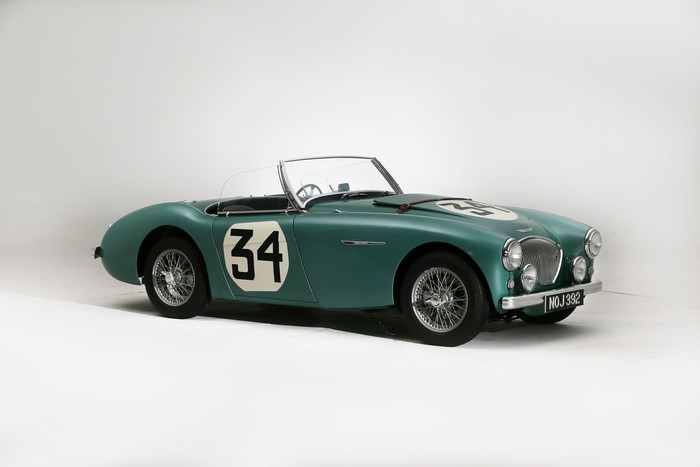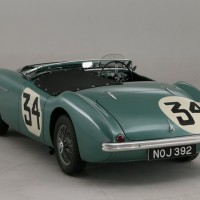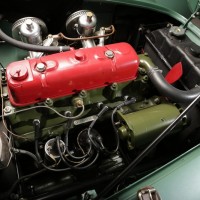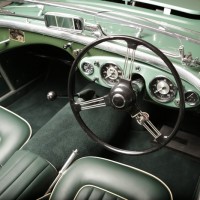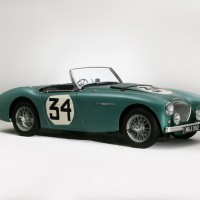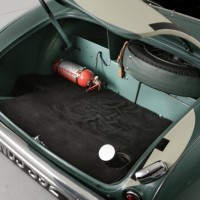SCM Analysis
Detailing
| Vehicle: | 1953 Austin-Healey 100 Special Test Car |
| Years Produced: | 1953 |
| Number Produced: | Four |
| Original List Price: | N/A |
| Tune Up Cost: | $300 |
| Chassis Number Location: | Plate on engine firewall |
| Engine Number Location: | Stamped on top flange of engine block |
| Club Info: | Austin-Healey Club, Helen House, Great Cornbow, Halesowen, West Midlands, B63 3AB |
| Website: | http://www.austinhealeyclub.com |
This car, Lot 350, sold for $1,182,019, including buyer’s premium, at Bonhams’ Goodwood Festival of Speed sale on July 12, 2013.
Although this car looks like a standard Healey 100, it is very special, and riddled with Works features.
It was custom-made under the direction of chief engineer Geoff Healey and experimental engineer Roger Menadue (who once proudly boasted that he had never used a torque wrench in his life) at The Cape, Warwick, during the early months of 1953.
The men had the assignment to build cars that would look like the new production 100 model but in reality would be much faster, mostly through “adding lightness,” as engine power only rose from the standard 90 horsepower to 103 horsepower.
The car retains the distinctive silhouette, but the whole body is in aluminum/magnesium alloy — Birmabright, the same stuff used to make Land Rovers — rather than just the front and rear shrouds. Even the bumpers are aluminum, their polished finish masquerading as stock chromed-steel items. There are disc brakes all round, as used in its later life (it did the 1953 Le Mans on drums), and the overdrive switch is mounted on the steering wheel spokes, as opposed to later Abingdon Works-built rally cars that carried it in the gear knob as an even faster way to change.
This was the Healey team feeling its way through competition preparation of a new model.
Patina only in historic photos
Although it has fantastic continuous history — and is the only Special Test Car to survive in its original form — as presented at Goodwood it was devoid of character after multiple restorations.
The last resto was a sympathetic job, to be sure, and the paint wasn’t too shiny, but it looked like a new car, with unworn seat leather. We were reminded of its past life not from the patina oozing from the old warhorse in question, but by the montage of blown-up pictures of it in action in the auction room. In addition, the auction catalog showed several pleasing period pictures depicting it at Le Mans — on track, on the starting grid and receiving attention at the Chateau de Chaisine, which was the Healey team’s base during the race.
The restorations have been meticulous. In 1994, the body was able to be re-used, although it needed floors, so new-but-correct pre-production flat pans were used, along with new sills. All associated original components were then refurbished rather than replaced.
While it would have been simpler and cheaper to fit heavy chromed-steel bumpers, it would have been period-incorrect, so new aluminum parts were manufactured at great expense.
Extra-large holes, believed to have been drilled during fitting of the larger fuel tank used at Le Mans in 1953, were found beneath the boot lining and fuel tank. The car also keeps the correct “taxi” gearbox with overdrive, complete with its original mounting brackets.
The documentation file included a report by Austin-Healey authority Nick Howell and Special Test Car/100S expert Joe Jarick, which was commissioned in 2009 just before the last refreshment. The report says, “Competition cars, by their very nature and use, are very often subject to major changes in the components during their career. NOJ 392 not only has its original and unique very early chassis, but also a large number of original major and minor components.”
The only major deviation from the original spec is the brakes. The Girling discs fitted in 1954 were still on the rear, but the front discs had been replaced by 3000 Mk1-type parts. With the assistance of both Geoffrey Healey and Roger Menadue (both now deceased), the original specification was defined and a reproduction set of Girling discs and calipers was produced and mounted at the front. There’s also a slightly bumpier camshaft, fitted during that restoration in the 1990s with an eye to competitive events.
So it’s a very original car that’s also very restored, if that isn’t a contradiction in terms. Perhaps “very restored but as original as can be” is closer to the mark.
Another famous 100
Let’s compare it with its sister, NOJ 393, also known as the “Death Crash Car” after it was involved in sparking the terrible 1955 Le Mans disaster in which more than 80 people died, including Mercedes W-196 driver Pierre Levegh.
Just for the record, I reckon the Healey driver, Lance Macklin, was the patsy and the Jaguar D-type-mounted Brit golden boy Mike Hawthorn was to blame, but political expediency pointed the finger at the Healey driver, who later sued Hawthorn for libel. Bonhams sold that car as a floorless basket case two years ago, it having been abandoned since 1969 after having had something of a club-racing life. Like this car, that one was recently restored in Australia.
The “Death Crash Car” fetched $1.3m in its unrestored state, which is not altogether surprising when you consider that for a certain type of collector, the sky would be the limit for a car so entwined in history.
Our subject car, although more original under the paint and with much more important — although less memorable — competition provenance, was probably never going to bring as much across the block. However, no doubt buoyed by its sale of “393,” Bonhams had high hopes, setting the estimate range at £500–£600k ($770k–$925k). This was more than double the top price achieved so far at auction by an ex-Works rally Healey.
As it happened, our subject exceeded the top estimate by £185,000 ($285,000), reaching almost $1.2m — a figure very close to the then-world-record price paid in 2008, just five years ago, for the Pat Moss 1960 Liege-Rome-Liege rally-winning 3000.
As the catalog pointed out, had these special Healeys been Ferrari 250 GTs, they would be described as alloy-bodied Competizione models. They are far rarer than their Italian counterparts. This one has retained all its major components, having never been substantially crashed or damaged, modified or abused. It will also pretty much open the doors to the best international historic events in the world — at far less money than a comparable red or silver car with similar provenance.
Is it worth eight times as much as an almost indistinguishable early aluminum production 100? Only the bidders can answer that, but at least one of them certainly thought so. ?
(Introductory description abridged from Bonhams’ catalog entry.)
